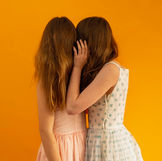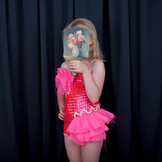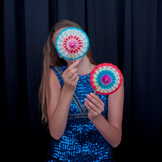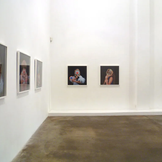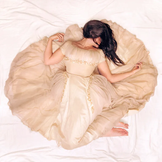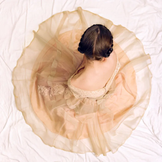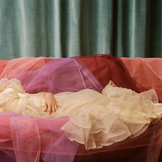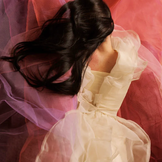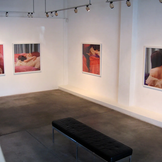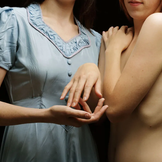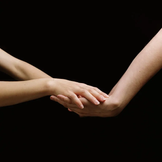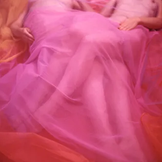
DEBORAH PAAUWE
b. 1972, West Chester, Pennsylvania
Lives and works in Adelaide, Australia
Deborah Paauwe has exhibited nationally & internationally in over 35 solo exhibitions and 100 group exhibitions throughout Australia, London, Europe, Asia, New Zealand and United States. In 2000 she completed her MA in Fine Art at the Chelsea School of Art in London, UK supported by the Anne & Gordon Samstag International Visual Arts Scholarship. Her work is represented in over 35 collections including the National Gallery of Australia; National Gallery of Victoria; Art Gallery of South Australia; Art Gallery of Western Australia and Artbank. Exhibitions include 2004 Adelaide Biennial of Australian Art; Photo LA, Los Angeles, USA; Wall Power: Significant Contemporary Australian Photography & Photo Media, London; Imagining the Everyday, Pingyao International Photography Festival, China. In 2004 Wakefield Press published a hardcover book (SALA publication) on Paauwe’s work titled “Beautiful Games” written by Wendy Walker.
THE OTHER TWIN / 2024
In The Other Twin, Deborah Paauwe presents a captivating series of photographic works that delve into the realms of female identity and childhood. Through deliberate anonymity and hidden expressions, Paauwe invites viewers to explore the complexities of identity through the lens of concealment. Utilising hair and crocheted doilies as masks, antique lace and vintage dresses as focal points, and the intertwining of hands against translucent fabrics, Paauwe crafts a narrative that blurs the lines between the present self and the obscured past. Gingham fabric, handmade collars, ricrac, and bows add layers of nostalgia and intricacy to the series, revealing a world where imperfections, scars, and pen marks coexist with beauty and mystery. By playing with ambiguity and emphasising the importance of composition and cropping, Paauwe challenges viewers to interpret and engage with her work on a personal level, inviting them to unravel the enigmatic stories woven within each frame.
Paauwe has exhibited nationally & internationally in over 35 solo exhibitions and 100 group exhibitions throughout Australia, London, Europe, Asia, New Zealand and United States. In 2000 she completed her MA in Fine Art at the Chelsea School of Art in London, UK supported by the Anne & Gordon Samstag International Visual Arts Scholarship. Her work is represented in over 35 collections including the National Gallery of Australia; National Gallery of Victoria; Art Gallery of South Australia; Art Gallery of Western Australia and Artbank. Exhibitions include 2004 Adelaide Biennial of Australian Art; Photo LA, Los Angeles, USA; Wall Power: Significant Contemporary Australian Photography & Photo Media, London; Imagining the Everyday, Pingyao International Photography Festival, China.
SUMMER OF '83 / 2018
In 1983, Deborah Paauwe had not yet moved to Australia from the United States. Only eleven years old, she was facing those transitional years when the innocence of childhood diminishes. When the warm days of summer are marked by sleeping, slow dreaming or busy interludes with friends. Paauwe introduces this body of work with a diptych in blue where a barefoot girl reclines amidst an excess of tulle. This is the ‘Summer of ‘83’, full of provocative memories of now unfashionable pleats, dots and lace trim on synthetic fabrics in pastel and citrus hues.
Psychologists speak of adolescence as an explorative process, a crucial time in the formation of self, and the cognition of self in relation to others. This is a period when parents are shunned in favour of peers and pushing against boundaries is a part of the everyday. Consequently, it is also a time of increased vulnerability when friendships made, or broken, impact on long term emotional stability, social success and ultimately the resilience of one’s global self-esteem.
The young girls that populate the series huddle together protective of their aspirations – to be centre stage, to be admired. Their garish dance costumes lack the classic simplicity of the ballet tutu. Instead the bands of tassels, ribbon and sequins are suggestive of proud, dedicated mums chatting as they stitch backstage at rehearsals. Mums who live vicariously through the status of their daughters in a competitive arena. On the sidelines, they cling to the last vestiges of parental power, hopeful their children realise a better life.
The artist’s leitmotif of freefalling tresses secures the girls’ anonymity, locking from view the openness of their eyes and self-conscious smiles. Instead what comes into focus is one girl’s chipped baby-blue nail polish or the fine silver band on an index finger. There is uniformity in the shade, texture and length of their hair. The pale and supple skin of their exposed limbs implies the benefits and underlying values of the middle-class – accessibility to education and health care. These young beauties are defined by the norms of their broader community. They belong to each other.
What is apparent in the languorous gestures of Paauwe’s pubescent bodies is attitude, defensiveness and nonchalance. With their heads close, secrets are whispered and opinions supported. Each individual’s victory becomes a validation and affirmation of their belonging, which contributes to the communal kudos. Conversely, when life serves a blow to one this all-girl clan rally in support with affectionate caresses and comforting arms. There is a familiarity between the girls, which holds the artist’s nostalgia for adolescence in an incorruptible stasis.
Allison Holland, Curator, Australian Centre for Photography, 2018
STOLEN RIDDLES / 2015
That breathing in and out remembers lost or quiet things you always wanted [1]
Somewhere I still have the photographs my friends and I took of one another dressed up in my sister’s clothes when we were only eleven. We posed with props that empowered us to perform new and different identities: my sister’s electric guitar, a plastic tiara and a purple exercise ball. This memory is of a specific hot-blooded communication that occurs between girls, where the move from childhood to adolescence is navigated together and where there exists a tension between solitary and shared experiences. The cloudy photographs, taken on a disposable camera, show undeveloped bodies in poses that awkwardly practice how to simultaneously present the allure and integrity of being a woman.
Child play is a safe and private rehearsal for ‘real’ life’s performance. The intimate spaces created in pre-pubescent secret-sharing, lies and games create a particular momentary excitement, which can verge on both the erotic and sinister. Play between girls exposes that the nature of intimacy between women is inextricable from emotions responding to the socially constructed performance of femininity. This unconscious awareness of performance creates a tender, trusting understanding of how it feels to be perpetually watched. Though never overtly explained that this is the way of the world, through social codes and the pervasive construction of gendered behaviour, certain rules are learned.
Becoming a woman felt a bit like becoming famous [2]
Deborah Paauwe’s staged portraits of pre-pubescent girls are intimate considerations of the volatile transition from girlhood to womanhood. The images capture the complexities of navigating this time with secrecy, ambiguity and take a sensitive approach to the physical indicators of innocence budding into awareness.
Like most of Paauwe’s photographs, faces in the Stolen Riddles series are obscured from view. We glimpse teeth awkwardly finding their position, presenting a confronting and grotesque image of childhood development, further heightening its precariousness and uncertainty. Subtle suggestions of narrative are constructed through the coupling of the girls, emphasising their solitude in the singular photographs. The physical interaction between the girls draws attention to their vulnerability. A protective arm folds over a flat chest, unformed hips are embraced and supple arms are linked in mutual union. When viewed as a whole, the tension between the girls coupled and isolated speaks of states of loneliness and alienation, where the difficulty of navigating private and public spaces becomes an experiment with freedom and an emerging awareness of the significance of beauty is formed.
In Stolen Riddles there is a focus on the lushness and allure of hair. The wigs are sumptuous and appealing. In some photos they look like ripe fruit, while in others they are arranged awkwardly and shambolically, like soft shields or bad hiding places. The obstruction of faces with hair has an uneasy edge and gives the impression of dual identities, heightening the sense of a shared secret game. Of course in all games there is an initiator and an initiated; a complex web of power relations. There is something more assertive about the girls in this series. The gestures of hair-shaking and protective unification have a strength that feels as though the subjects play a more active role than in Paauwe’s previous work.
…once we had the peculiarities and history of our bodies in place we went on to the stories…
The contrast of young girls together and in private is at the centre of this series as Paauwe reveals a tender embrace, the desire for escape and a sense of alienation. These images could be seen as responses to memories or might remind us of the mysterious ways our own childhood recollections manifest in adult experience. This transitional time in the lives of pre-pubescent girls is both intriguing and uncomfortable. There is pleasure in looking at these photographs, yet the contrast between the girls’ innocence and awareness destablilises our gaze, creating a pervading sense of unease. To counter this discomfort we try to decipher what it is, and in that process, create narratives of our own.
Kate Power, 2015
[1] Eimear McBride, A Girl is a Half Formed Thing (Melbourne: Text Publishing, 2013).
[2] Caitlin Moran, How To Be a Woman (London: Ebury Press, 2012).
[3] Alice Munro, Too Much Happiness (London: Vintage Books, 2010).
THE PAINTED MIRROR / 2012
The desire to perform and the want to conceal would seem counterintuitive in theory. The mere thought of subjecting oneself to the gaze of the camera, the reach of the microphone or the lights of the stage conjures a nightmarish prescience in some, just as it engenders an almost lustful flight of fancy for others.
But we are complicated beasts; confused compounds of projected familial aspirations, inner desires and outward appearances. The semblance of bashfulness or extroversion hardly equates to a resolved behavioural or psychological state. The troubled, shambolic lives of countless of our most renowned dramatic and musical icons would seem to render the correlation between public face and personal fulfilment perilously tenuous. Appearances can often be deceiving.
It’s a notion worth taking into account when spending time with The Painted Mirror, the most recent body of work from American-born artist Deborah Paauwe. Employing the sequins, sheen and symbology of the child beauty pageant as its register, this suite of staged portraits skirt a particular tension between public and private. Indeed, while Paauwe’s close-cropped, highly gestural photographs capture her young teen (and even younger tween) protagonists striking various melodramatic poses in full, garish kitsch regalia, there is something askew.
As with much of Paauwe’s work, the girls’ faces are obscured and erased from view; in this case, via a series of handheld props, such as vintage, hand-painted mirrors and colourful paper fans. It’s a telling motif. Like earlier work, too, there are irrevocable linkages to personal history and autobiography here. That Paauwe cites her part-Chinese heritage – specifically, a cultural sensibility of concealing one’s emotions – as an inspiration for the series adds an intriguing layer.
With the face concealed, there is little personal legitimacy to these poses. Indeed, how does one read the body without the aid of the face? Our eyes fall upon the details – the position of the hand, the fall of the hair, the subtle stain of recently removed nail polish. The children’s gestures, costumes and bodies become an almost arbitrary system of signifiers. They resemble and hint at emotion and joy and reticence, but they fail to offer confirmation.
What might have been considered as a light-hearted study of primping, play and “girls being girls” is in fact far more complex in its disposition. These are girls are play-acting learned femininity. They are living out contrived drama, emotion and behaviour of someone else’s dream.
THE YELLOW LINE / 2010
There is a spectre in these scenes. There is an intimacy of memory, an unbreakable resilience between present and past.
Economy is of the essence here. Even the slightest of gestures become crucial. A touch or twist or link of hands; a head turned; an index finger, slightly raised. The actions are muted somehow; tender, far from overt. But they are significant.
The two figures at the centre of Deborah Paauwe’s new body of work are permanently connected, irrevocably entwined.
The Yellow Line Paauwe refers to in this collection of large-scale, staged, highly gestural colour photographs is one of the road. Born in Pennsylvania, her early life was spent in the back seat of the family station wagon, traversing the highways of 1980s America.
What we witness in Paauwe’s photographs, however, subverts romantic, cinematic connotations of travel. Here, the signifiers of freedom – endless highways, sky and empty expanse – are obscured and erased. The austere, symmetrical environs of an underground car park take their place. The yellow line creeping into frame leads not to a distant horizon, but to the arbitrary swirl and texture of a concrete wall.
As with the majority of Paauwe’s work, the pair of protagonists here are female, faces obscured from view. Their body shape, hair colour, signature of movement and gesture, are remarkably similar, almost familial. Yet, there is an ambiguousness to the figures. Age is indecipherable at first glance. Both are lean and long-limbed, in a youthful way. They cling together in their matching Sunday best, tightly framed and cropped against cold grey.
With time, more details come to light. Disparities between the pair become more evident. Bruises become decipherable, as do veins, the deep scarring on a leg. We come to realise that one subject to be a woman and the other a child. In a shift from Paauwe’s recent works from the exhibitions Kindle & Swag (2005) and The Crying Room (2006) – which resonated with a kind of lush sensuousness and sexuality – the figures in The Yellow Line espouse a different brand of intimacy. Their touch becomes one of nurture, one of connection via mutual experience. It is not necessarily one of choice.
The idea that the woman and child might be an allegory for Paauwe’s adult and childhood selves seems particularly compelling. Though separated by time, their shared memory ensnares and entraps them both.
The Yellow Line is a parable not of boundless freedoms, but perhaps of our inability to break from our past.
Dan Rule
Dan Rule is an arts and music writer from Melbourne. He writes the 'Around the galleries' column in The Age and is the co-founded of independent art publishing imprints And Collective and Erm Books.
CAROUSEL / 2008
Do you own a collection of love letters or cards – a surprise bundle which you unearth now and again when moving house or spring cleaning? No matter how many years or decades go by, there are certain notes which have retained their original resonance, even if tainted by subsequent events. It takes more will than we have been able to muster to completely sever these memories or bonds of personal history, imbued as they are with hopeful desires and impetuous behaviour. Such traces of love or lust are not yet ready for the recycling bin. However, with the benefit of retrospectivity we sense the ghosts of déjà vu and inevitability. No matter the freshness of the feelings once pressed into the service of a relationship, those sentiments had always been said (by others) before and would be conveyed by us again.
It may seem a leap from those communiqués of ardor to Deborah Paauwe’s current body of photographs. On the other hand, her images are also suffused with symbolic power, that of photography, and the representational and associative possibilities of her medium and subject matter across time. Like a lover, Paauwe understands the pull of love and yearnings of the flesh. She explores the effectiveness of her medium as an organic substance, a surface producing images of beauty, sentiment, metaphor and other universal values. By conjuring other bodies with her photography Paauwe presses us to question our relationships with these others she controls, and to ask just what the artist is proposing here?
Across the twentieth century, photographers have tested questions of how the truth and goodness of images can be called to account. Paauwe extends this tradition of image-making. Confining her sitters to children and young adults enables a boundary to be drawn around a subject, limiting the zone in which she will tighten the screws. The strategy is then to survey and zoom in on her subjects. In the current series Carousel, Paauwe’s lens has the forensic scrutiny of a diligent anthropologist or apprehensive matriarch. No detail escapes the camera’s meticulous recording of hands, feet, fabrics and other physical details.
The format of these photographs of ‘restless mysteries’ tidies young women into something unnatural: each is almost perfectly geometric, a unitary circle within a square. Shot from above, the viewer seems to take the role of a microscope lens, pressing down on its specimen. Any personal or womanly differentiation is minimised, drained by the colouration of the light and surrounding whorls of closely toned cotton and chiffon.
These photographs clearly distinguish themselves from family or studio images, most particularly for the lack of visibility of the girls’ faces. Even the freshness of youth is masked in this way, only bared necks or vulnerable female backs are exposed to view. The sense of strangeness is heightened by the dresses, which evoke another, earlier decade, appearing incongruous on the frame of a young girl whose body does not give off the excitement of dressing up and childishly play acting for the camera. Laying bare an enigma, the truth of the relations in Paauwe’s images can only be accessed by the viewer’s imagination.
The catatonic stillness and repeated, decisive moments of the Carousel series are clearly an artifice, but a deliberately elusive play act on the part of the artist. Are the downcast and hair-covered faces to suggest modesty, or euphoria? Is this a lover’s strategy of designing similarity in order to expose difference or highlight beauty in the flawed details of bitten finger nails, ill-fitting gowns, inaccurately parted hair and stained frocks?
Coils, dots, spirals, wheels and whorls; Paauwe turns the symbolic potential of photography over and over like a lover composing an undeliverable poem. There is no relief for the desire that loops the viewer’s gaze across image after image, no end is offered to the cycling of related ideas. Her romance with flesh and feelings is a fascination shared historically with artists from Inges to Matisse, and remains a compulsion with her contemporaries such as Kiki Smith.
Photographs both mark and connect points across time, memorialising others and reinvigorating feelings held in suspension, like remembering a face recalled by a long forgotten valentine. Love and mourning, life and loss: both circulate through images and texts. Such connectivity is also to be found in the myths and theories that explain humanity and provide our understanding of nature, as well as being absorbed into academic disciplines from psychoanalysis to economics when birth is described as part of death, beauty found in ugliness, consistency reliant on instability, the void part of wholeness… Similarly we find contemporary and intertwined sensations, such as that of the unspoilt and the violated, the demur and despoiled, responses that circulate in our viewing of the Carousel images.
With compositions reminiscent of the centralised orb of an eye, the images of Carousel uncannily look back at us. Their permanent stare is a reminder not only of the endurance of the print but also the archiving power of the mind, with its often capricious recall of past infatuations and adored ones. Paauwe pours over the interlinked topology of reality, image and memory, and invites the magic of transubstantiation from material facts to unconscious emotions. She helps us see that the camera cannot compare to the godlike eye, even though photography is less and less forgiving of human imperfections. Aware of photography’s inevitable fickleness and infidelities, will we ever love her exquisite wheel again?
Zara Stanhope
Deputy Director, Senior Curator
Heide Museum of Modern Art
THE CRYING ROOM / 2006
Deborah Paauwe's recent photography draws together flesh and fabric. It is at this junction that the significant relationship between textiles and the human body becomes an interface to the social world. This new collection of images continues the artist's highly refined visual strategy of young, female, headless bodies in contrast with cloth, objects and other skin. However, this time there is more of an emphasis on image styling. In The Crying Room the arrangement of carefully selected components raise purple, peach, green, pink and red tulle, velvet and chiffon to a key position along side the human elements of Paauwe's images. These fabrics lie with the bodies of the artist’s subjects, in, on and around them. The peaks and troughs of net and pile are a soft but tangible landscape setting for a new, capricious, world created by Paauwe.
In light of this, The Crying Room – a series of ten large square type C photographs – resembles another genre of image making driven by temporal scrambling, image fetishism and the drive for desire and illusion: fashion photography. This series skates along the rim of fashion imagery more than any of her previous bodies of work. Indeed, The Crying Room might be said to evoke fashion photography's key principles, where the powers of seduction lie in an ability to veil the real and create a dream space where viewers lose themselves in fantasy and reverie.
Photographer Richard Avedon once described his role at Vogue as 'selling dreams, not clothes'. Fashion advertising is not concerned with cataloguing the everyday or with facts, instead, it "hides the origins of things." It is this template that seems to offer the most productive window through which to view Paauwe’s photographs. There are a growing number of fashion photographers, that, like Paauwe generate images that snare desire without the aid of an obvious commodity object. Instead, they exist on the level of the sign and tempt viewers through the construction of mesmerising enigma.
Fashion academic Caroline Evans writes that the fashion commodity has "evolved into a mutant form with the capacity to insert itself into a wider network of signs". Under these terms, fashion is a prolific virus with the power to infiltrate already highly symbolic zones. According to Evans, this mutable identity is defined by fashion’s large web of relations and ability to define itself "as image, as cultural capital, as consumer goods, as fetish, art exhibition, item on breakfast television, show invitation, or collectable magazine". Art photographs such as Paauwe's that share an appearance with fashion imagery then, might find an entry point into this system of relayed signs, suggesting a kind of image power that exists only outside the white walls of a gallery.
Whereas in past series by Paauwe they have played a key role, the absence of children now moves the uncertain narrative that is a central feature of her work to an adult fantasy. Here the risk or anxiety associated with viewing faceless, splayed bodies can be an issue of semi-subversive engagement without such high moral ties as the bodies seem to unselfconsciously invite scrutiny. Images of the adult body can be pushed even to the brink of death and humiliation in the name of mass-consumed viewing pleasure as the fashion photographs of Izima Kaoru and Juergen Teller show. Paauwe uses this tension and invites that same pleasure on two levels. The surface register combines young smooth flesh in a opulent setting of rich fabrics while the layer of detail that sits beyond is what ‘pricks’ us, the punctum that Roland Barthes described.
Bitten nails that leave long figures with protein stumps, a red back rash and too big veins are snippets of the 'real' which Paauwe uses to draw us further into the image for long, close looking. Such 'defects' in the beauty so consciously realised are left to wrestle in a game of fascination and repugnance while the little ruptures they induce are dazzling. Paauwe plays on the fact that the commodification of desire most often leads to the promotion of relentlessly similar beauty icons. Her models shed their status as the human embodiment of the dress-maker's dummy and in fact invite a kind of unpleasure when we see beyond the airbrushing and other touch-ups that characterise most fashion photography.
Paauwe's two female characters, and their sexy slothful state, have a secretive, far-away feeling that is a mixture of youthful self-interestedness and ennui. The women wear floaty dresses with ruffled necklines and waist-ties in antique cream silks. These garments are so strongly infused with nostalgia and an infantilism that the appearance of the women's loosely draped fabrics, their glossy tumbling hair and the invitation to pry into their secret whispers and actions, prompt a range of psychic, voyeuristic and fetishistic affects. Paauwe’s stagecraft turns these girl-women into image objects, from their previous role as live beings. Moreover, our access to these figures is given a heightened sense of prying interference when we consider the title of the new series. Crying Rooms are sound-proofed areas in cinemas and churches, designed to dull the sound of crying babies. Seemingly, Paauwe has put us in the position of watching two women weep who do not want to be found out.
Fashion photography can be a kind of guillotine for women's bodies that dissects an image so as to extract key information. In the sixteenth century, this kind of dismembering took place in a blazon, a type of poem that described the body parts of a woman. When traded between poets, the blazon created an image of women through their selected anatomy, not unlike the experience of flicking through a fashion magazine. Paauwe's amputated bodies, and the way her camera selects only slices of cocked and prone postures is perhaps a modern day blazon; a poem to women’s bodies that forms an epic work in light of an oeuvre of odes to cropped figures. She offers visual pleasure but asks how such a response and its inherent instability and transience resonates in the present.
Kate Rhodes, 2006
CHINESE WHISPERS / 2004
DARK FABLES / 2004
Innocence is a quality frequently misapplied to the young.
It is a notion projected onto children by adults. Adolescents particularly crave knowledge and experience (if not actually academic learning). Childhood games typically anticipate what it might be like to be grown up (to be an agency in the world).
A tiger cub leaping onto the back of its sibling, tumbling over and nuzzling its neck may look like cute play, but it is preparation for bringing down an axis deer or a wild boar. A rehearsal for the struggle of life. The young girl who preens and flirts with her father is rehearsing a role of adult life in a script of which she is yet not fully aware. It's part of the evolutionary programming: to try things out and see what works. To quarry meaning and effect. And we, as adults, through our responses, determine what patterns of activity are reinforced and which abandoned. In this we are complicit in the roles and narrative of play.
It is within the interstices of childhood recollection and adult complicity that the artist Deborah Paauwe situates her oeuvre. Her photographs are based upon youthful memories and feelings. They are not necessarily directly autobiographical but rather conjure recollections of how it felt to be young, growing up, with life in a state of flux. Each body of work features anonymous female players - sometimes a child, sometimes an adolescent, sometimes a young woman. In each there is an interplay between the qualities of her costume, her apparent age and the narratives suggested by her body language. However, each series has had a quite distinct tone - sometimes vivid in colour or florid in pattern, at others soft, sugary and diffuse.
Here in the new body of work, Dark Fables, each female figure wears a party frock and make-up. The painted faces are stylized - part kindergarten, part Commedia del'Arte, part cartoon menagerie. Some hint at the animalistic, some carry the chill pulchritude of a porcelain doll. The poses are deliberate and self-possessed. Knowing.
- Alasdair Foster 2004
























